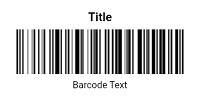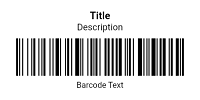The EAN-13 barcode is a globally recognized symbology used for encoding 13-digit numeric data. It is an extension of the original EAN (European Article Number) system, designed to provide a standardized method for identifying retail products. The EAN-13 barcode is widely adopted in the retail industry for product identification and inventory management.
Introduced in 1976, the EAN-13 barcode was developed as an enhancement to the earlier EAN-8 format to support a broader range of products and more detailed product information. The 13-digit format was designed to accommodate the growing needs of international retail and logistics, offering a universal standard that facilitates global trade.
Technical Specifications
The EAN-13 barcode encodes a 13-digit numeric code, including a check digit for error detection. The barcode is structured with a combination of bars and spaces, each representing a digit or part of the encoded data. The EAN-13 structure includes:
- Start and Stop Patterns: Unique patterns at the beginning and end of the barcode signal the start and finish of the data sequence.
- Left and Right Groups: The 13-digit code is divided into two parts. The left half contains six digits, while the right half contains six digits plus the check digit. Each half uses different encoding patterns for better data separation.
- Checksum: A modulo 10 check digit is calculated and appended to the end of the data to verify accuracy and detect errors.
Checksum Calculation
The EAN-13 checksum is calculated using the following steps:
- Multiply each digit of the barcode by a weight factor. The weights alternate between 1 and 3, starting with the rightmost digit.
- Sum the results of these multiplications.
- Find the remainder when this sum is divided by 10.
- Subtract the remainder from 10 to get the check digit. If the remainder is 0, the check digit is 0.
The check digit ensures the integrity of the encoded data, allowing scanners to detect errors and verify that the barcode has been read correctly.
Advantages and Disadvantages
The EAN-13 barcode offers significant advantages, including its international standardization, which ensures compatibility across global markets. Its 13-digit format allows for a large number of unique product identifiers, making it suitable for diverse product catalogs. The inclusion of a check digit enhances data accuracy and reduces the likelihood of scanning errors.
However, the EAN-13 barcode has limitations, such as its fixed length of 13 digits, which may not accommodate all product information needs. Additionally, while it is efficient for numeric encoding, it does not support alphanumeric data or special characters, limiting its use in applications requiring more complex data representation.
EAN-13 Applications
The EAN-13 barcode is extensively used in the retail sector and beyond:
- Retail Products: Commonly found on product packaging, the EAN-13 barcode facilitates efficient checkout, inventory management, and product tracking in stores.
- Supply Chain Management: Helps in managing and tracking products through various stages of the supply chain, ensuring accurate data exchange between manufacturers, distributors, and retailers.
- International Trade: Provides a standardized method for product identification that is recognized and accepted worldwide, simplifying global commerce.
Comparison with Other Barcode Symbologies
Compared to other barcode formats, such as UPC-A, which encodes 12 digits, EAN-13 offers an additional digit for more detailed product identification. While similar in function, EAN-13 provides a larger number space and international compatibility. Unlike Code 128, which supports a broader range of characters including alphanumeric data, EAN-13 is limited to numeric encoding but benefits from its widespread adoption and standardization.
The EAN-13 barcode is a robust and widely used symbology designed for encoding 13-digit numeric data. Its development as an enhancement to earlier barcode formats has established it as a global standard for retail and supply chain management. The barcode's international recognition, data accuracy through its check digit, and extensive use in product identification make it a valuable tool in modern commerce, despite its limitations to numeric data and fixed length.


